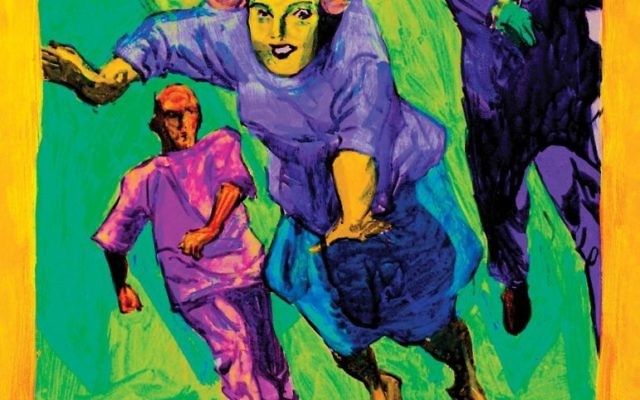613 Reasons to Study
Artist provides colorful interpretations of all mitzvot
By Susanne Katz
Judaism and art have always had a tenuous relationship. From the prohibition to make images or likenesses of man or beast, to the requirement to make beautiful adornments for religious observance, the do’s and don’ts have not revealed a clear picture of just what Jewish art is.
Bible stories were communicated to somewhat illiterate churchgoers through paintings and sculptures on the walls, ceilings and pedestals of churches. Jewish spiritual art included embellishment and iconography meant to enhance rather than to educate. Later artistic embellishments included illuminated manuscripts, marriage contracts, haggadah manuscripts and magillot.
Sculptures and relief were the most objectionable art forms, according to Talmudic law.
Archie Rand believes that painting is a means of biblical interpretation that, when seen through the Jewish lens, takes it beyond iconography. His images are not literal but are his own artistic commentary, meant to engage and entertain the viewer.
His goal is to be provocative and to entice the viewer to look at and to talk about what he sees.
In his new book, “The 613,” Archie Rand has created a page-by-page visual interpretation of each commandment, or mitzvah, in a comic-book-type format accompanied by the location of the text in the Talmud.
Rand’s pairings of bright images with the 613 mitzvot, with line-by-line translations, are unorthodox, playful and in your face. Each painting highlights an idea of the text. He asks us to look at these mitzvot differently — or, at the very least, to just look.
Rand ordered 700 canvases and started to work on this project. He made his own acrylic paint, which he mixed with resins and additional pigments. The gold borders he crafted from gold and acrylic paints. The entire process took five years.
This is an ambitious project, but, as he explained, “This is not my first engagement with enormous projects.”
Rand, born in 1949, lives in Brooklyn and is the presidential professor of art at Brooklyn College. In an interview, Rand recalled his secular Jewish existence in Brooklyn, complete with after-school Hebrew training and a bar mitzvah. He has produced paintings and murals that have been exhibited around the world.
Rand’s large-scale project “The Letter Paintings,” completed between 1968 and 1971, incorporates the names of African-American musicians. The paintings have been shown individually in galleries and together in an exhibition at the Carnegie Museum of Art in 1983.
Rand’s large-scale projects exploring Jewish themes include:
- The B’nai Yosef murals, 1974, Brooklyn, known as the Painted Shul.
- “Twelve Tribes” stained-glass windows, 1980, Anshe Emet Congregation, Chicago.
- “The Patriarchs” stained-glass windows, 1981, Temple Sholom, Chicago.
- “Seven Days of Creation” murals, 1984, Jerusalem Women’s Teachers’ College.
- Beth El Congregation murals, 2003, Fort Worth.
- Congregation Beth-El mural, 2005, San Antonio.
- “The 613,” a freestanding painting, at 1,700 square feet considered one of the largest ever made.
Rand was inspired by Judaism and influenced by the feisty Jewish humor of Lenny Bruce and Mel Brooks. Jewish humor and the Jewish imagination enthralled viewers and readers with comic

books, Mad magazines and the ever-present superheroes.
Rand’s characters, he said, are neither Jewish nor superheroes. They are generic and user-friendly, and they have much value to a Jewish audience. Looking at these paintings will not make Jews more observant, but it will make them more familiar with the mitzvot.
Mitzvot are found in the Talmud, but the Talmud does not provide us with a listing. The 12th-century sage Maimonides (Rambam) was the first person to write a systematic and comprehensive listing of the code of Jewish law in his “Mishnah Torah.” The 613 mitzvot consist of 248 positive and 365 negative commandments — the do’s and don’ts. There are also seven rabbinic mitzvot.
A mitzvah is a good deed, to be done with joy and enthusiasm, and it is every Jew’s obligation to study each mitzvah, to learn about it. The 613 relate to family, the poor, gentiles, dietary laws, business practices, agriculture, clothing, vows, and just about all the possible rules to living that could be followed in a lifetime.
I had plenty of time on my recent trip to and from Cuba, so while on the various planes, I looked at each of the 613 paintings and the first introductory painting and read each of the 613 texts. What I learned, by just looking and reading, was what Rand had intended.
“The point is to be provocative and make folks want to read the texts,” Rand said. “The Jewish religion requires argument. I want these images to be entertaining, to invite the viewer to look at it and talk about it. It won’t make the viewer more observant, but it will make them think and be more familiar with the mitzvot.”
I had studied a few of the 613 but had never learned the significance of some mitzvoth that, for me, brought up more questions than answers. I have more studying to do to understand the following:
- No. 14, “To love converts.”
- No. 62, “Not to engage in astrology.”
- No. 127, “A man cannot remarry his divorced wife.”
- No. 420, “To be seen at the Temple three times a year — Passover; Shavuot, the Festival of Weeks; and Sukkot, the Festival of Booths.”
I asked Rand what he learned by studying and visualizing these 613 mitzvot. His answer: “I would not have read them all!”
—
The 613
By Archie Rand
Blue Rider Press, 640 pages, $45
At the festival Nov. 11





comments